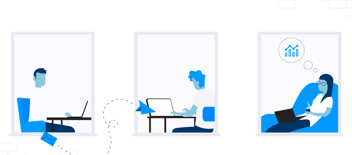Be aware that publicly shared data can be mined and analyzed
It doesn’t matter whether data is structured or unstructured – it has no use unless it can be analyzed to get insights for decision-making.
But this is where text analysis comes into play. Text analytics can provide valuable new insights to help businesses with everything starting from making use of data available to becoming more responsive to customers. Such software can discover patterns and trends from plain text data to support business processes.
Today, Péter Szekeres, CEO of Neticle talks about which industries can benefit greatly from implementing AI, what precautions or security tools can be installed to ensure online security, and much more.
How did the idea of Neticle come to life? What has your journey been like?
Back in 2010, a study came out that showed how through analyzing updates shared on Twitter, one could predict changes in the stock market. That was a mind-blowing discovery about the power of automated text analysis and hugely inspired us to get into this line of work.
I graduated as a Business Information Technologist from Corvinus University of Budapest (BCE), where I was also the president of a large student organization. In 2012, with two of my fellow BCE graduates – Zoltán Csikós and Róbert Horváth – we founded the text and media analysis company Neticle.
During our studies, we realized that providing solutions to businesses with a lot of textual data was something that we could be good at, as we had the necessary tech knowledge and we also really wanted to try our hand at building a startup. That’s how Neticle came to be.
Can you introduce us to the text analysis platform? What technology do you use to analyze vast amounts of data?
We have our own Natural Language Processing algorithm that understands text with human precision. It recognizes sentiments, topics, and different entities as well – it can analyze thousands of entries/posts in a matter of seconds.
On the platform, the results of the text analysis (and also the quantitative results) are visualized on more than 100, highly customizable charts. You can choose from sample reports, or you can add charts in any unique order and use the specific filter settings that you need. You can also drill down on any of the charts to see details.
In your opinion, which industries would greatly benefit from AI-powered data analysis?
Almost any industry can benefit from it. In today’s world, most enterprises retain large amounts of textual data, be it in the form of direct customer feedback, call center transcripts, in-house documents, or chatbot conversations (and the list goes on).
Of course, there’s also unsolicited feedback all over the internet, which can be collected (and it’s worth doing so). With that said, the typical industries that like to work with us so far are retail, telecommunications, banking, insurance, health, tourism, and agencies.
How did the recent global events affect your field of work?
A few of our clients had to cut back on marketing or PR budgets (especially in the hotel and recreation sector), which affected our cooperation and therefore, our finances. However, there was no major setback. Most of our clients know that social listening is a necessary investment in the long term.
Remote working was another challenge that we had to tackle – to do that, we started a biweekly survey called “Team Health Check,” to make sure nobody felt left out and to provide a regular feedback channel. We still use it, even though our office is now open and more and more colleagues like to come in at least a couple of times a week.
What tips would you give to companies looking to get more value out of their data?
We recommend thinking about their goals first. What matters the most to them? Is it a great customer experience? Or maintaining a wonderful online reputation? Do they want to monitor competitors, or improve their own communication?
Data analysis, and especially text analysis can lend a hand in all of these areas, and provide a strong foundation for data-driven decision-making. However, finding the right custom solution might take a while - choosing something that responds to their unique needs is key.
Despite all the solutions available today, some companies still refuse to upgrade their operations with new and innovative measures. Why do you think that is the case?
The way we see it, some companies regard these solutions as something that’s nice to have, but not crucial to their operation. Innovation can seem scary and costly, especially when the underlying technology and its benefits are unknown to them.
Our consultancy approach was adopted precisely because we know that text analytics has gigantic value, but it’s a relatively new technology, and you can’t expect all companies to just get on board with it from one day to the next. We would like to show what they can achieve with it, and find the best solutions for everyone.
What other company processes do you hope to see automated in the near future?
Human resources and employee experience are examples where we see great potential. Within Neticle, we’re already using text analysis in the Team Health Check survey – employees can give free text feedback, and then Zurvey.io, our CX/EX platform analyzes the answers and informs the management about employee pain points and love points.
Are there any precautions or security tools that you think need to be taken in this age of ever-changing technology?
As an internet user, pay attention to what you share publicly and what’s only for a closed friend circle. Be aware that publicly shared data can be mined and analyzed (and it will be). Use strong passwords and two-step authentication where possible.
As a company, make sure you only work with GDPR-compliant providers. If you have sensitive data to analyze, choose a solution where the data doesn’t have to leave your system.
What’s next for Neticle?
As a scale-up, it is a top priority to involve more investors, so that will be happening in the next few years. Other than that, our short-term goal is to achieve full European language coverage and then continue with languages from the Middle East and the Far East.
Originally published on Cybernews.com
Share:


